Sedimentary Differentiation Characteristics of Organic Matter and Phosphorus in Eutrophic Lake Special Zones
Abstract
1. Introduction
2. Materials and Methods
2.1. Study Area Overview
2.2. Sample Collection and Analysis
2.3. Phosphorus Fractionation and Analysis
2.4. Organic Matter Extraction and Analysis
2.5. Data Processing
3. Results
3.1. Vertical Distribution of TP and TOC in Sediment Cores
3.2. Vertical Distribution of DOM in Sediment Cores
3.3. Vertical Distribution of P Fractions in Sediment Cores
4. Discussion
4.1. Mechanisms Driving the Inverse Distribution of TP and Organic Carbon
4.2. Evolutionary Trends in P Fractions Within Sedimentary Cores of Lake Qilu
4.3. DOM–Phosphorus Coupling Mechanisms in Sediments and Their Ecosystem Feedback
5. Conclusions
Supplementary Materials
Author Contributions
Funding
Data Availability Statement
Acknowledgments
Conflicts of Interest
References
- Lin, S.-S.; Shen, S.-L.; Zhou, A.; Lyu, H.-M. Assessment and Management of Lake Eutrophication: A Case Study in Lake Erhai, China. Sci. Total Environ. 2021, 751, 141618. [Google Scholar] [CrossRef] [PubMed]
- Smith, V.H.; Tilman, G.D.; Nekola, J.C. Eutrophication: Impacts of Excess Nutrient Inputs on Freshwater, Marine, and Terrestrial Ecosystems. Environ. Pollut. 1999, 100, 179–196. [Google Scholar] [CrossRef]
- Huo, D.; Gan, N.; Geng, R.; Cao, Q.; Song, L.; Yu, G.; Li, R. Cyanobacterial Blooms in China: Diversity, Distribution, and Cyanotoxins. Harmful Algae 2021, 109, 102106. [Google Scholar] [CrossRef] [PubMed]
- Balaji Prasath, B.; Lin, Z.-R.; Su, Y.-P.; She, C.-X.; Lin, H.; Zhang, C.-W.; Yang, H. Adsorption-Release Characteristics of Phosphorus and the Community of Phosphorus Accumulating Organisms of Sediments in a Shallow Lake. Sustainability 2021, 13, 11501. [Google Scholar] [CrossRef]
- Gong, J.; Du, H.; Zhu, T.; Hu, F.; Cui, L.; Liu, K.; Li, X.; Yang, D.; Wang, C.; Chu, R. Structure of Zooplankton Community in Qilu Lake and Its Ralationship with Environmental Factors. Wetl. Sci. 2023, 21, 358–366. [Google Scholar] [CrossRef]
- Yang, H.Y.; Yang, S.; Liu, Y.; Liu, X.F. Seasonal Succession of Plankton Community and Driving Factors in Hypereutrophic Qilu Lake (Yunnan-Guizhou Plateau). Res. Environ. Sci. 2020, 33, 876–884. [Google Scholar] [CrossRef]
- Huang, W.; Dong, X.; Tu, C.; Yang, H.; Chang, Y.; Yang, X.; Chen, H.; Che, F. Response Mechanism of Sediment Endogenous Phosphorus Release to Functional Microorganisms and Its Cyanobacterial Growth and Disappearance Effects. Sci. Total Environ. 2024, 906, 167676. [Google Scholar] [CrossRef]
- Cheng, X.; Huang, Y.; Li, R.; Pu, X.; Huang, W.; Yuan, X. Impacts of Water Temperature on Phosphorus Release of Sediments under Flowing Overlying Water. J. Contam. Hydrol. 2020, 235, 103717. [Google Scholar] [CrossRef]
- Liu, J.; Zhang, Q.; Chen, M.; Dai, J.; Gu, W.; Wen, S.; Du, Y. Composition of Organic Matter-iron-phosphorus Associations in Sediments of Algae- and Macrophyte-Dominated Zones in Lake Taihu. Chem. Geol. 2023, 622, 121375. [Google Scholar] [CrossRef]
- Ren, H.; Wang, G.; Ding, W.; Li, H.; Shen, X.; Shen, D.; Jiang, X.; Qadeer, A. Response of Dissolved Organic Matter (DOM) and Microbial Community to Submerged Macrophytes Restoration in Lakes: A Review. Environ. Res. 2023, 231, 116185. [Google Scholar] [CrossRef]
- Yuan, H.; Guan, T.; Liu, E.; Ji, M.; Yu, J.; Li, B.; Cai, Y.; Yuan, Q.; Li, Q.; Zeng, Q.; et al. Regime Difference between Macrophyte and Cyanophyta Dominance Regulate Microbial Carbon Sequestration Mode in Lake Sediments. Water Res. 2024, 267, 122481. [Google Scholar] [CrossRef] [PubMed]
- Yao, Y.; Li, D.; Chen, Y.; Han, X.; Wang, G.; Han, R. High-Resolution Characteristics and Mechanisms of Endogenous Phosphorus Migration and Transformation Impacted by Algal Blooms Decomposition. Sci. Total Environ. 2022, 820, 152907. [Google Scholar] [CrossRef] [PubMed]
- Du, Y.; An, S.; He, H.; Wen, S.; Xing, P.; Duan, H. Production and Transformation of Organic Matter Driven by Algal Blooms in a Shallow Lake: Role of Sediments. Water Res. 2022, 219, 118560. [Google Scholar] [CrossRef]
- Cheng, Y.; Jiao, L.; Cheng, Q.; He, J.; Zhang, Y.; Ding, S. The Evolution of a Typical Plateau Lake from Macrophyte to Algae Leads to the Imbalance of Nutrient Retention. Water Res. 2023, 236, 119937. [Google Scholar] [CrossRef]
- Li, J.; Ianaiev, V.; Huff, A.; Zalusky, J.; Ozersky, T.; Katsev, S. Benthic Invaders Control the Phosphorus Cycle in the World’s Largest Freshwater Ecosystem. Proc. Natl. Acad. Sci. USA 2021, 118, e2008223118. [Google Scholar] [CrossRef]
- Wen, S.; Lu, Y.; Dai, J.; Huang, X.; An, S.; Liu, J.; Liu, Z.; Du, Y.; Zhang, Y. Stability of Organic Matter-Iron-Phosphate Associations during Abiotic Reduction of Iron. J. Hazard. Mater. 2023, 449, 131016. [Google Scholar] [CrossRef] [PubMed]
- Wen, S.; Lu, Y.; Luo, C.; An, S.; Dai, J.; Liu, Z.; Zhong, J.; Du, Y. Adsorption of Humic Acids to Lake Sediments: Compositional Fractionation, Inhibitory Effect of Phosphate, and Implications for Lake Eutrophication. J. Hazard. Mater. 2022, 433, 128791. [Google Scholar] [CrossRef]
- Klamt, A.-M.; Qian, F.; Hu, K.; Wang, J.; Huang, L.; Li, R.; Chen, G. The Rise and Fall of Primary Producers and Consumers in a Multiply-Stressed Shallow Lake (Lake Qilu, China) over the Last 200 Years. Ecol. Indic. 2021, 129, 107891. [Google Scholar] [CrossRef]
- Li, N.; Chang, F.; Zhang, H.; Liu, Y.; Wu, H.; Duan, L.; Liu, P.; Lu, Z.; Bi, R. Lake Sediment Records of Climate Change and Human Activities in the Qilu Lake Basin of Yunnan Province over the Past 70 Years. J. Yunnan Norm. Univ. 2016, 36, 60–66. [Google Scholar] [CrossRef]
- Qian, F.; Zhang, K.; Chen, G.; Yin, Y.; Wang, J.; Hu, K. Sediment-inferred recent pattern and drivers of environmental and ecological changes at Qilu Lake. J. Lake Sci. 2018, 30, 1109–1122. [Google Scholar] [CrossRef][Green Version]
- Qi, Y.; Liu, Y.; Liu, S.; Li, Y. Health Evaluation of Aquatic Ecosystem of Qilu Lake. Environ. Sci. Surv. 2015, 34, 81–85. [Google Scholar] [CrossRef]
- Du, H.C.; Zhu, T.; Gong, J.; Hu, F.; Sun, Y.; Li, X.M.; Yang, D.G.; Miao, X.J.; Wang, C.L.; Huang, Z.S. Phytoplankton community structure, eutrophication and fish productivity of Qilu Lake, a plateau lake. Freshw. Fish. 2023, 53, 75–83. [Google Scholar] [CrossRef]
- Psenner, R. Fractionation of Phosphorus in Suspended Matter and Sediment. Arch. Hydrobiol. Beih. 1988, 30, 98–110. [Google Scholar]
- Hupfer, M.; Zak, D.; Roβberg, R.; Herzog, C.; Pöthig, R. Evaluation of a Well-established Sequential Phosphorus Fractionation Technique for Use in Calcite-rich Lake Sediments: Identification and Prevention of Artifacts Due to Apatite Formation. Limnol. Ocean Methods 2009, 7, 399–410. [Google Scholar] [CrossRef]
- Ruban, V.; López-Sánchez, J.F.; Pardo, P.; Rauret, G.; Muntau, H.; Quevauviller, P. Selection and Evaluation of Sequential Extraction Procedures for the Determination of Phosphorus Forms in Lake Sediment. J. Environ. Monit. 1999, 1, 51–56. [Google Scholar] [CrossRef]
- Begum, M.S.; Lee, M.-H.; Park, T.J.; Lee, S.Y.; Shin, K.-H.; Shin, H.-S.; Chen, M.; Hur, J. Source Tracking of Dissolved Organic Nitrogen at the Molecular Level during Storm Events in an Agricultural Watershed. Sci. Total Environ. 2022, 810, 152183. [Google Scholar] [CrossRef]
- Chen, B.; Huang, W.; Ma, S.; Feng, M.; Liu, C.; Gu, X.; Chen, K. Characterization of Chromophoric Dissolved Organic Matter in the Littoral Zones of Eutrophic Lakes Taihu and Hongze during the Algal Bloom Season. Water 2018, 10, 861. [Google Scholar] [CrossRef]
- Cory, R.M.; McKnight, D.M. Fluorescence Spectroscopy Reveals Ubiquitous Presence of Oxidized and Reduced Quinones in Dissolved Organic Matter. Environ. Sci. Technol. 2005, 39, 8142–8149. [Google Scholar] [CrossRef]
- Li, L.; Wang, S.; Jiao, L.; Yu, Y.; Ding, S.; Wang, Y. Vertical Variation of Phosphorus Forms in Lake Dianchi and Contribution to Release. Environ. Sci. 2016, 37, 3384–3393. [Google Scholar] [CrossRef]
- Rydin, E.; Malmaeus, J.M.; Karlsson, O.M.; Jonsson, P. Phosphorus Release from Coastal Baltic Sea Sediments as Estimated from Sediment Profiles. Estuar. Coast. Shelf Sci. 2011, 92, 111–117. [Google Scholar] [CrossRef]
- Dan, S.F.; Liu, S.-M.; Yang, B. Geochemical Fractionation, Potential Bioavailability and Ecological Risk of Phosphorus in Surface Sediments of the Cross River Estuary System and Adjacent Shelf, South East Nigeria (West Africa). J. Mar. Syst. 2020, 201, 103244. [Google Scholar] [CrossRef]
- Ahlgren, J.; Tranvik, L.; Gogoll, A.; Waldebäck, M.; Markides, K.; Rydin, E. Sediment Depth Attenuation of Biogenic Phosphorus Compounds Measured by 31P NMR. Environ. Sci. Technol. 2005, 39, 867–872. [Google Scholar] [CrossRef] [PubMed]
- Paludan, C.; Jensen, H.S. Sequential Extraction of Phosphorus in Freshwater Wetland and Lake Sediment: Significance of Humic Acids. Wetlands 1995, 15, 365–373. [Google Scholar] [CrossRef]
- Jin, X.; Wang, S.; Pang, Y.; Wu, F.C. Phosphorus Fractions and the Effect of pH on the Phosphorus Release of the Sediments from Different Trophic Areas in Taihu Lake, China. Environ. Pollut. 2006, 139, 288–295. [Google Scholar] [CrossRef]
- Cavalcante, H.; Araújo, F.; Noyma, N.P.; Becker, V. Phosphorus Fractionation in Sediments of Tropical Semiarid Reservoirs. Sci. Total Environ. 2018, 619–620, 1022–1029. [Google Scholar] [CrossRef]
- Zhang, J.; Li, H.; Wiesner, M.G.; Eglinton, T.I.; Haghipour, N.; Jian, Z.; Chen, J. Carbon Isotopic Constraints on Basin-Scale Vertical and Lateral Particulate Organic Carbon Dynamics in the Northern South China Sea. J. Geophys. Res. Ocean. 2022, 127, e2022JC018830. [Google Scholar] [CrossRef]
- Ren, Z.; He, J.; Zhao, H.; Ding, S.; Duan, P.; Jiao, L. Water Depth Determines Spatial and Temporal Phosphorus Retention by Controlling Ecosystem Transition and P-Binding Metal Elements. Water Res. 2022, 219, 118550. [Google Scholar] [CrossRef]
- Wen, S.; Wang, H.; Wu, T.; Yang, J.; Jiang, X.; Zhong, J. Vertical Profiles of Phosphorus Fractions in the Sediment in a Chain of Reservoirs in North China: Implications for Pollution Source, Bioavailability, and Eutrophication. Sci. Total Environ. 2020, 704, 135318. [Google Scholar] [CrossRef]
- Canfield, D.E.; Farquhar, J. Animal Evolution, Bioturbation, and the Sulfate Concentration of the Oceans. Proc. Natl. Acad. Sci. USA 2009, 106, 8123–8127. [Google Scholar] [CrossRef]
- Chari, N.R.; Taylor, B.N. Soil Organic Matter Formation and Loss Are Mediated by Root Exudates in a Temperate Forest. Nat. Geosci. 2022, 15, 1011–1016. [Google Scholar] [CrossRef]
- Rani, V.; Schwing, P.T.; Jayachandran, P.R.; Preethy, C.M.; Sreelekshmi, S.; Joseph, P.; Bijoy Nandan, S. Carbon Stocks and Sequestration Rate in Mangroves and Its Major Influencing Factors from Highly Urbanised Port City, Southern India. J. Environ. Manag. 2023, 335, 117542. [Google Scholar] [CrossRef]
- Ai, Y.; Cheng, H.; Quan, W.; Wang, Q.; Gong, Y.; Yang, K.; Wu, Y.; Zhang, J.; Huang, D. Response of Phytoplankton Community to Dissolved Organic Matter Composition and Lake Trophic State. J. Environ. Manag. 2024, 370, 122793. [Google Scholar] [CrossRef] [PubMed]
- Diaz, R.J.; Rosenberg, R. Spreading Dead Zones and Consequences for Marine Ecosystems. Science 2008, 321, 926–929. [Google Scholar] [CrossRef]
- Hupfer, M.; Lewandowski, J. Oxygen Controls the Phosphorus Release from Lake Sediments—A Long-Lasting Paradigm in Limnology. Int. Rev. Hydrobiol. 2008, 93, 415–432. [Google Scholar] [CrossRef]
- Ministry of Ecology and Environment of the People’s Republic of China. Yunnan Yuxi Qilu Lake Pollution Control Addresses Symptoms but Not Root Causes, Water Quality Fails to Improve Long-Term. Published on 17 May 2021. Available online: https://www.mee.gov.cn/ywgz/zysthjbhdc/dcjl/202105/t20210517_833137.shtml (accessed on 31 March 2025).
- Ni, Z.; Wang, S.; Wu, Y.; Pu, J. Response of Phosphorus Fractionation in Lake Sediments to Anthropogenic Activities in China. Sci. Total Environ. 2020, 699, 134242. [Google Scholar] [CrossRef]
- Da-Peng, L.; Yong, H. Sedimentary Phosphorus Fractions and Bioavailability as Influenced by Repeated Sediment Resuspension. Ecol. Eng. 2010, 36, 958–962. [Google Scholar] [CrossRef]
- Molnár, Z.; Dódony, I.; Pósfai, M. Transformation of Amorphous Calcium Carbonate in the Presence of Magnesium, Phosphate, and Mineral Surfaces. Geochim. Cosmochim. Acta 2023, 345, 90–101. [Google Scholar] [CrossRef]
- Lv, Y.; Zhang, M.; Yin, H. Phosphorus Release from the Sediment of a Drinking Water Reservoir under the Influence of Seasonal Hypoxia. Sci. Total Environ. 2024, 917, 170490. [Google Scholar] [CrossRef]
- Lake, B.A.; Coolidge, K.M.; Norton, S.A.; Amirbahman, A. Factors Contributing to the Internal Loading of Phosphorus from Anoxic Sediments in Six Maine, USA, Lakes. Sci. Total Environ. 2007, 373, 534–541. [Google Scholar] [CrossRef]
- Lin, Z.; Liu, L.; Lian, E.; Jiang, X. Preferential Remineralization of Phosphorus from Organic Matter in River-Dominated Coastal Sediments. Sci. Total Environ. 2024, 921, 170935. [Google Scholar] [CrossRef]
- Chen, M.; Hur, J. Pre-Treatments, Characteristics, and Biogeochemical Dynamics of Dissolved Organic Matter in Sediments: A Review. Water Res. 2015, 79, 10–25. [Google Scholar] [CrossRef]
- Chen, C.; Deng, W.; Xu, X.; He, J.; Wang, S.; Jiao, L.; Zhang, Y. Phosphorus Adsorption and Release Characteristics of Surface Sediments in Dianchi Lake, China. Environ. Earth Sci. 2015, 74, 3689–3700. [Google Scholar] [CrossRef]
- Yang, F.; Tang, C.; Antonietti, M. Natural and Artificial Humic Substances to Manage Minerals, Ions, Water, and Soil Microorganisms. Chem. Soc. Rev. 2021, 50, 6221–6239. [Google Scholar] [CrossRef]
- Blattmann, T.M.; Liu, Z.; Zhang, Y.; Zhao, Y.; Haghipour, N.; Montluçon, D.B.; Plötze, M.; Eglinton, T.I. Mineralogical Control on the Fate of Continentally Derived Organic Matter in the Ocean. Science 2019, 366, 742–745. [Google Scholar] [CrossRef]
- Jin, Z.; Liao, P.; Jaisi, D.P.; Wang, D.; Wang, J.; Wang, H.; Jiang, S.; Yang, J.; Qiu, S.; Chen, J. Suspended Phosphorus Sustains Algal Blooms in a Dissolved Phosphorus-Depleted Lake. Water Res. 2023, 241, 120134. [Google Scholar] [CrossRef]
- Li, H.; Yang, G.; Ma, J.; Wei, Y.; Kang, L.; He, Y.; He, Q. The Role of Turbulence in Internal Phosphorus Release: Turbulence Intensity Matters. Environ. Pollut. 2019, 252, 84–93. [Google Scholar] [CrossRef]
- Fakhreeva, A.V.; Nosov, V.V.; Voloshin, A.I.; Dokichev, V.A. Polysaccharides as Effective and Environmentally Friendly Inhibitors of Scale Deposition from Aqueous Solutions in Technological Processes. Polymers 2023, 15, 1478. [Google Scholar] [CrossRef]
- Liu, J.; Yang, J.; Cade-Menun, B.J.; Hu, Y.; Li, J.; Peng, C.; Ma, Y. Molecular Speciation and Transformation of Soil Legacy Phosphorus with and without Long-Term Phosphorus Fertilization: Insights from Bulk and Microprobe Spectroscopy. Sci. Rep. 2017, 7, 15354. [Google Scholar] [CrossRef]
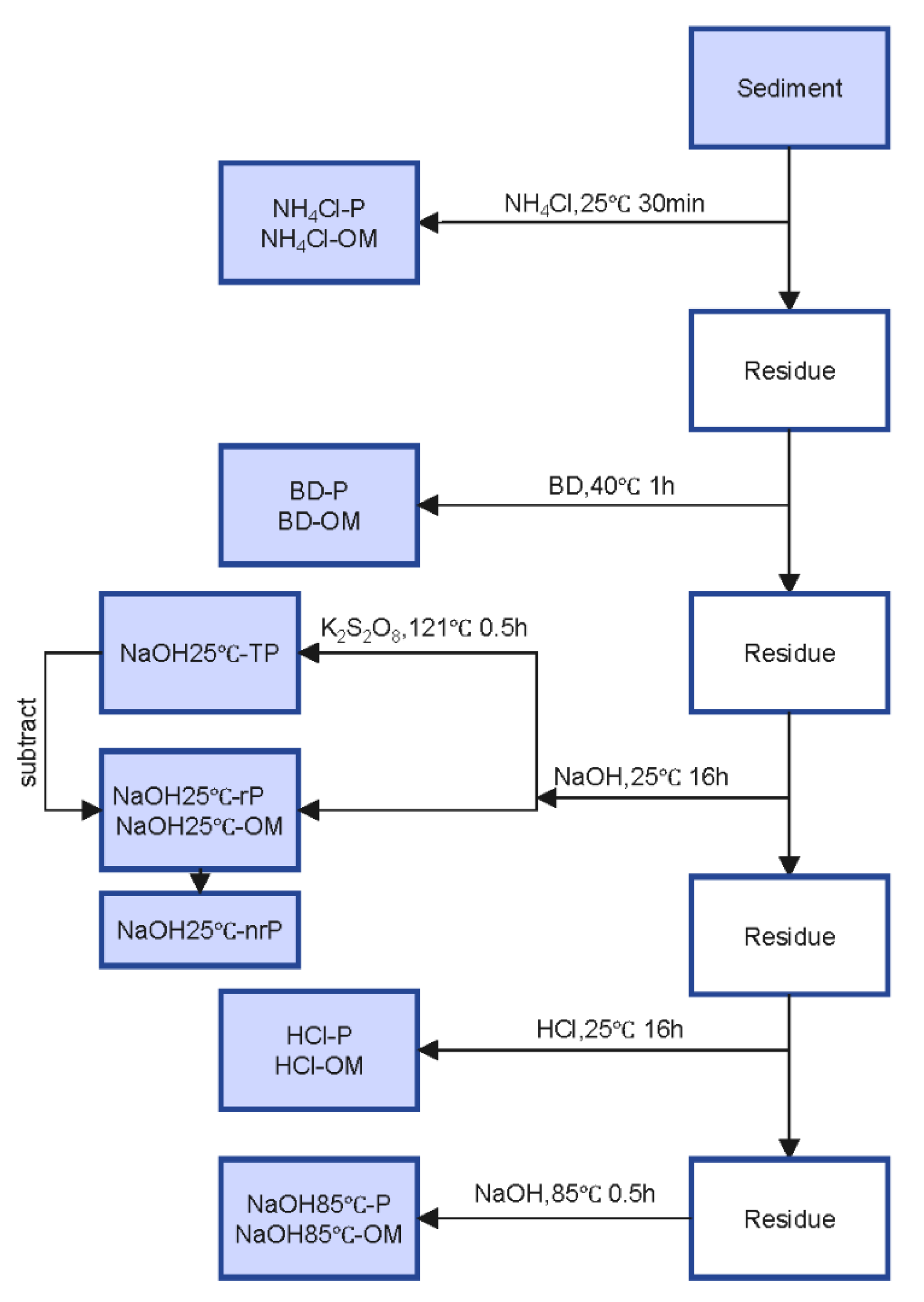
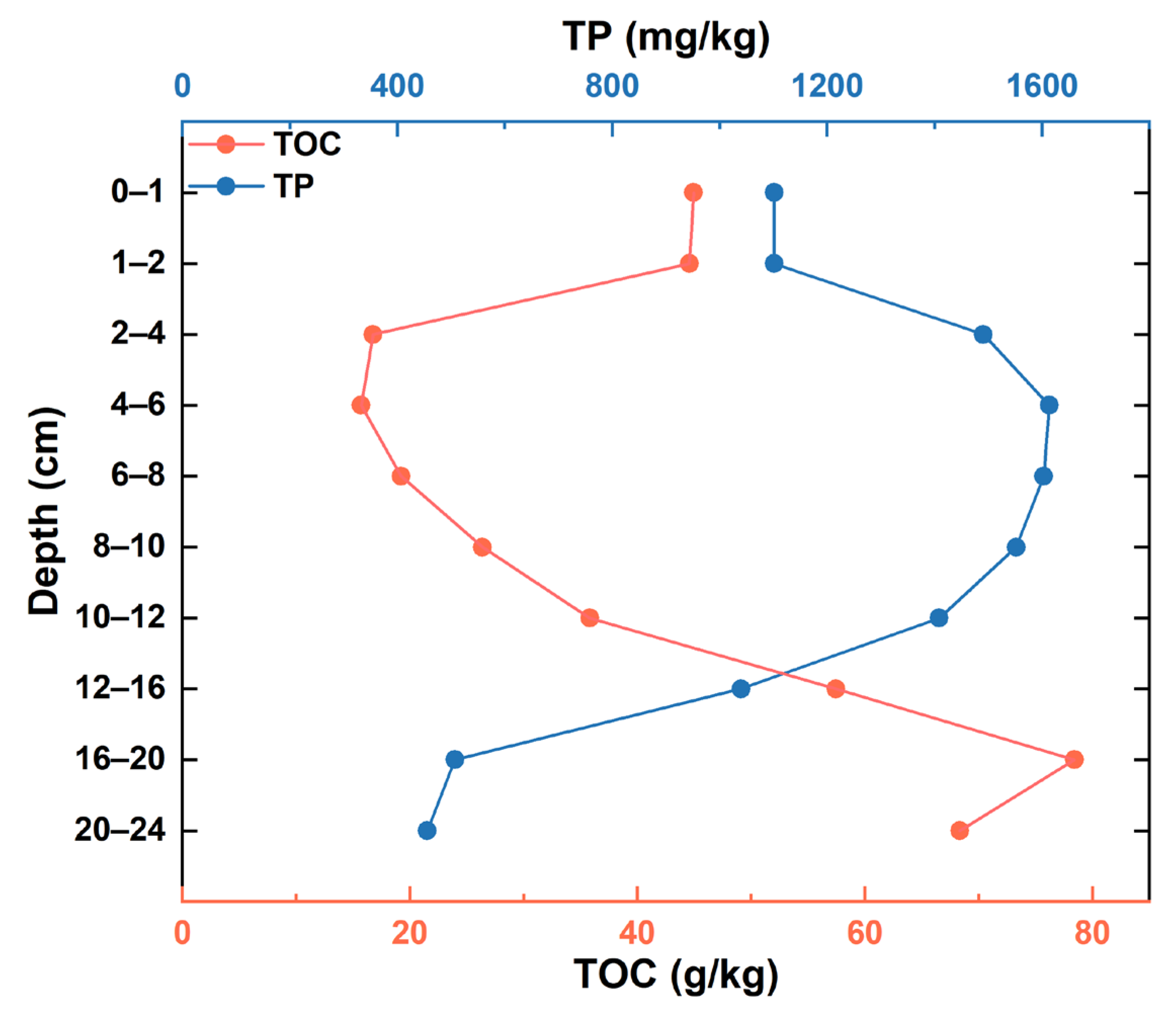
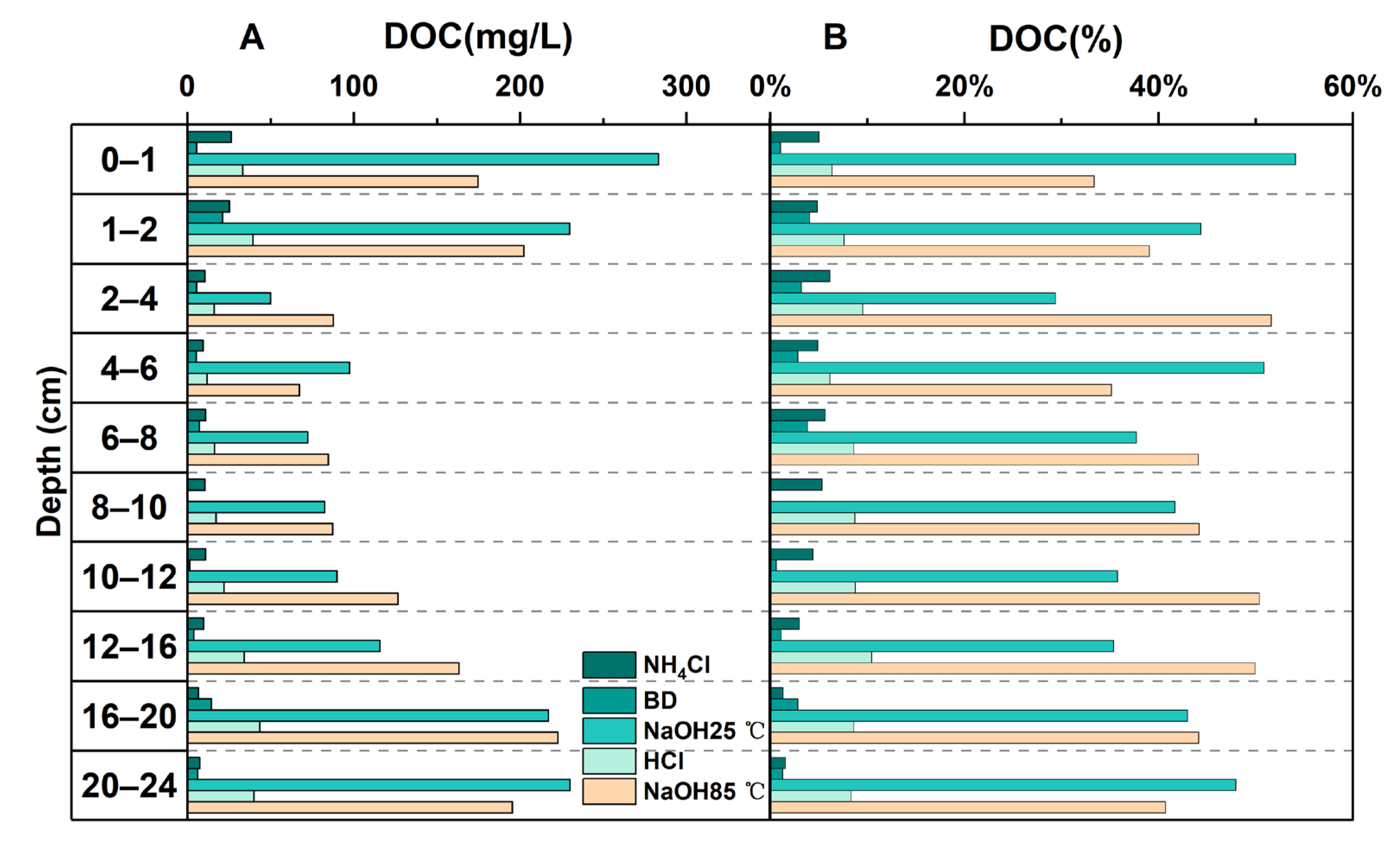
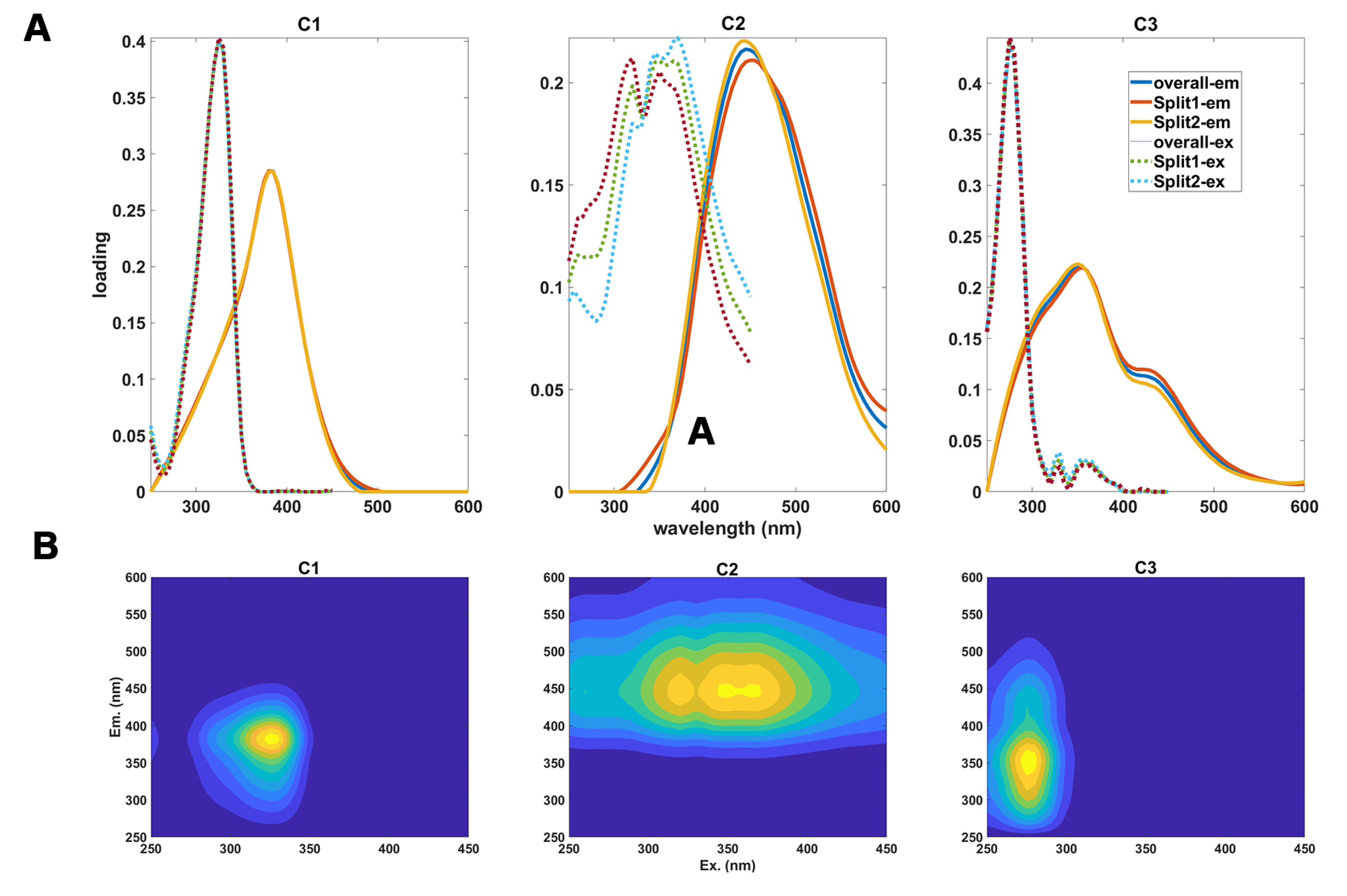

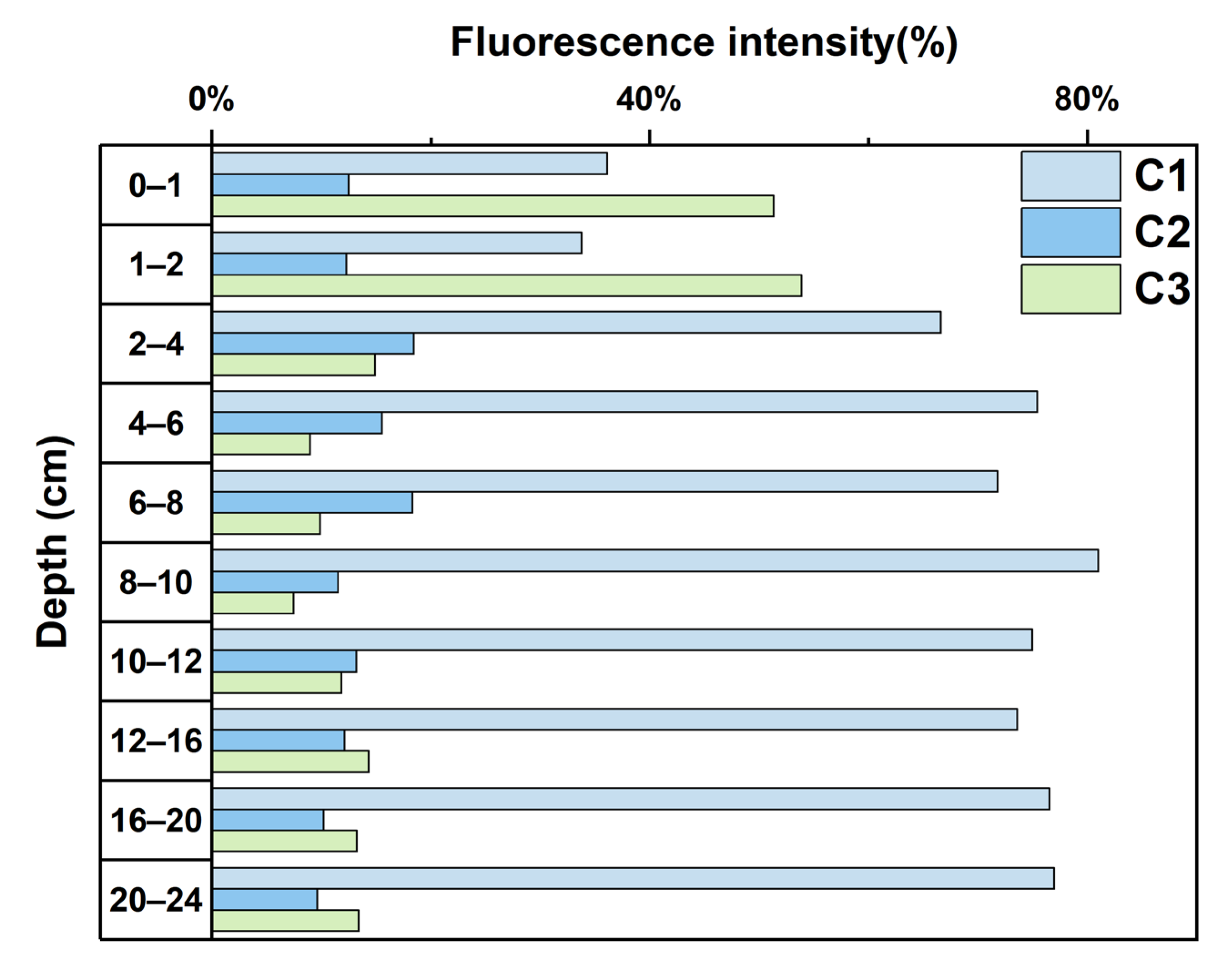

Disclaimer/Publisher’s Note: The statements, opinions and data contained in all publications are solely those of the individual author(s) and contributor(s) and not of MDPI and/or the editor(s). MDPI and/or the editor(s) disclaim responsibility for any injury to people or property resulting from any ideas, methods, instructions or products referred to in the content. |
© 2025 by the authors. Licensee MDPI, Basel, Switzerland. This article is an open access article distributed under the terms and conditions of the Creative Commons Attribution (CC BY) license (https://creativecommons.org/licenses/by/4.0/).
Share and Cite
Liu, Y.-P.; Song, D.; Jiao, L.-X.; Zheng, J.-L.; Zhang, M.; Yao, B.; Yan, J.-Y.; Wu, J.-X.; Wen, X. Sedimentary Differentiation Characteristics of Organic Matter and Phosphorus in Eutrophic Lake Special Zones. Water 2025, 17, 1899. https://doi.org/10.3390/w17131899
Liu Y-P, Song D, Jiao L-X, Zheng J-L, Zhang M, Yao B, Yan J-Y, Wu J-X, Wen X. Sedimentary Differentiation Characteristics of Organic Matter and Phosphorus in Eutrophic Lake Special Zones. Water. 2025; 17(13):1899. https://doi.org/10.3390/w17131899
Chicago/Turabian StyleLiu, Ya-Ping, Di Song, Li-Xin Jiao, Jin-Long Zheng, Miao Zhang, Bo Yao, Jing-Yi Yan, Jian-Xun Wu, and Xin Wen. 2025. "Sedimentary Differentiation Characteristics of Organic Matter and Phosphorus in Eutrophic Lake Special Zones" Water 17, no. 13: 1899. https://doi.org/10.3390/w17131899
APA StyleLiu, Y.-P., Song, D., Jiao, L.-X., Zheng, J.-L., Zhang, M., Yao, B., Yan, J.-Y., Wu, J.-X., & Wen, X. (2025). Sedimentary Differentiation Characteristics of Organic Matter and Phosphorus in Eutrophic Lake Special Zones. Water, 17(13), 1899. https://doi.org/10.3390/w17131899






